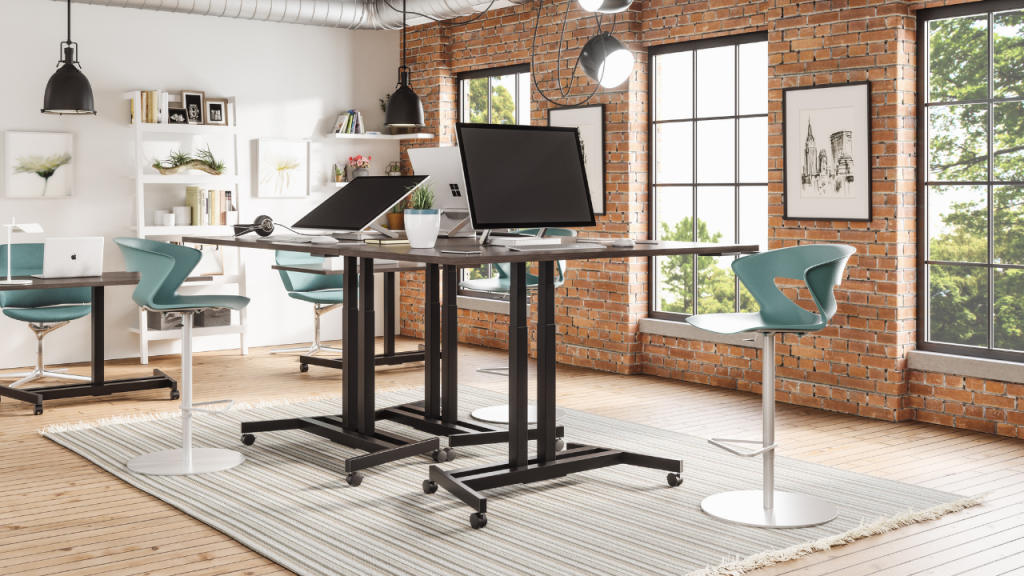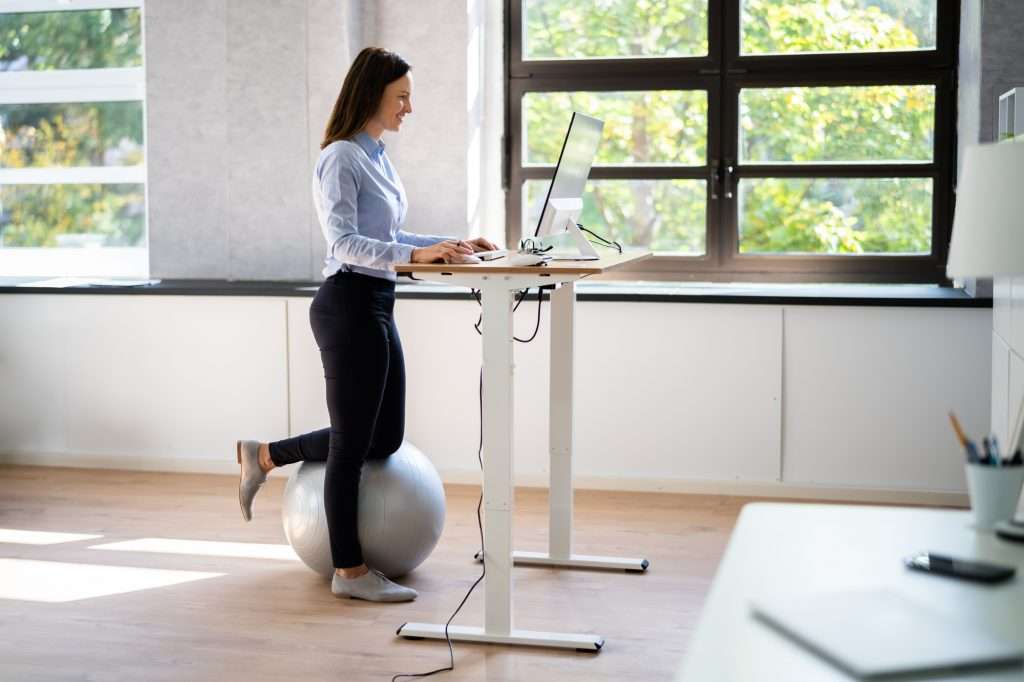Standing desks encourage people to move by making it easy to switch between sitting and standing positions. Studies provide evidence that using a standing desk could help reduce the negative health impacts associated with spending too much time sitting down.
As experienced researchers, we draw on the evidence obtained from relevant studies and reliable sources. We’ve identified some health benefits of standing desks in this article. We hope that this information will be useful for you.
What Is A Standing Desk?
A standing desk or stand-up desk is essentially a desk that allows you to stand while working. It’s available as fixed-height desks or adjustable desks.
The fixed-height standing desk stays at your standing height. The height-adjustable standing desk, also known as a sit-stand desk, allows you to adjust the height of the desk and easily switch between sitting and standing positions.

Health Benefits of Standing Desks Are Supported by Various Studies
For decades, doctors have warned us of the dangers of a sedentary lifestyle – meaning doing little to no physical activity – and its impact on your health.
Research shows that sitting for a long period of time can contribute to weight gain, high blood sugar, and elevated cholesterol levels, which are risk factors for cardiovascular diseases, even among otherwise healthy individuals [1].
In addition, prolonged sitting reduces oxygen supply to muscles, leading to fatigue and muscle soreness as well as back pain and depression [2, 3]. Overall, studies seem to suggest that sitting for long periods of time contributes to poor health and shorter life expectancy [4, 5, 6].
The American Heart Association recommends adults spend less time sitting and participate in at least 150 minutes of at least moderate-intensity aerobic physical activity throughout the week to offset some of the risks of being sedentary [7]. In fact, Research recommends that some physical activity, like standing, is better than none, in protecting against the risk of some diseases and all-cause mortality [8].
A study shows that standing up and moving around every half hour for about three minutes could help prevent long-term health issues caused by sitting too much [9]. Standing while working also enhances blood flow and increases brain activity and productivity [10, 11].
You can start out by taking a break from sitting every 30 minutes or standing instead of sitting whenever you get a chance. If you work at a desk, consider using a standing desk or a high table or counter as an alternative.
Many organizations start to recognize the health benefits of standing desks. Standing-capable desks have been shown to successfully decrease sitting time in the workplace [11]. They allow you to change your posture while still working without having to constantly move around the office.
Let’s have a look at some health benefits of standing desks and address the question ‘Are standing desks good for you?’.
Health Benefits of Standing Desks
Standing desks are becoming increasingly popular among people who want to reduce their sitting time at work. Any health benefits of standing desks are directly attributed to the act of standing. Standing desks enable people to stand or change positions more often than when using a regular desk.
Standing while working doesn’t just benefit your physical health; it can also help improve your mental well-being by helping you concentrate and remember things better. Here are some health benefits associated with using a standing desk.
1. Standing Helps Burn More Calories and Lower Risk of Obesity

Sitting contributes to weight gain while standing helps burn more calories and lowers the risk of obesity. When you stand, you can burn off some of the extra calories that would otherwise store as body fat. This is because standing uses more energy than sitting or lying down for the same amount of time [12]. Research also suggested that standing instead of sitting might be a potential solution to help people avoid gaining weight in the long run [13].
Researchers at Mayo Clinic analyzed 46 studies with 1,184 participants and found that standing burned 0.15 calories per minute more than sitting. So, by substituting standing for sitting for six hours a day, a 143.3-pound (65 kg) adult would expend an extra 54 kcal per day. Assuming no increase in food intake, that would equate to 5.5 pounds (2.5 kg) in one year. [13]
In another study, researchers examined the energy burned during sitting, standing, and walking of 74 participants. Each activity lasted 15 minutes. The study revealed that while sitting, people burned 80 calories per hour. Standing burned an additional eight calories or 88 calories per hour, and walking burned 210 calories per hour. Although standing burns slightly more calories than sitting, it adds up in the long run. So, by standing or walking instead of sitting, one had less risk of becoming overweight or obese. [14]
2. Using A Standing Desk May Help Lower Blood Sugar Levels
The impacts of sedentary behavior appear to go beyond simple obesity. Research shows that there is a strong connection between sitting for long periods of time and negative effects on blood sugar, which can increase the risk of type 2 diabetes.
For example, one study found that people who spend most of their time sitting during the day tend to have higher levels of fasting glucose than people who don’t. This means that their cells become less responsive to insulin or the body has difficulty processing sugar (glucose) into energy. This condition partly increases your risk of heart disease, stroke, and type 2 diabetes. [15]
Also, after eating a meal or snack, the blood sugar level rises immediately. In a healthy person, after eating, insulin works to bring down the blood sugar level to the pre-meal level two hours after eating. For some people, their blood sugar level remains high two hours following a meal. Because of this, the risk of developing type 2 diabetes increases when insulin doesn’t work properly in the body.
In general, the more the blood sugar levels rise after eating, the worse it is for your health. To ensure that insulin works properly, it is important not to overeat and also to adopt a habit that helps reduce the blood sugar spike, such as standing or walking after a meal.
A small study compared blood sugar responses to sitting and standing in 10 normally desk-based workers. Their blood sugar levels were measured following one afternoon of normal sitting work compared with one afternoon of the same work performed at a standing desk. The study revealed that standing for 185 minutes after lunch reduced the blood sugar spike by 43% compared to sitting for the same amount of time. [16]
Another study examines the blood sugar responses in 23 overweight/obese inactive office workers. It reported that alternating between sitting and standing every 30 minutes throughout the workday lowered their blood sugar by 11.1% on average. [17]
Although glucose is an essential fuel to your body, persistently high blood sugar levels increase your risk of diabetes and heart disease. While an increase in blood sugar level is expected after a meal – it’s part of your body’s natural response to food intake – people with high blood sugar levels are at a greater risk of developing type 2 diabetes.
Insulin helps the cells use glucose for energy and regulate sugar levels, but how effectively they use insulin depends on how physically active one is. So, one way to lower blood sugar levels at work is standing after a meal or standing while working.
3. Standing May Lower Risk of Heart Disease

Sitting too much overall also seems to increase the risk of heart disease. In fact, there is substantial evidence indicating that physically active people have a lower risk of heart disease [18].
One study examined more than 105, 677adults, aged between 35 and 70 years, from 21 countries for more than 10 years. It revealed that sitting for eight hours or more per day increased the risk of developing heart disease or dying from any course by about 20%, compared to people who sat for less than four hours per day.
Even sitting for six to eight hours a day may increase the risk of heart disease by 13%. Reducing sedentary time and increasing physical activity may help lower heart disease rates. [19]
Another research analyzed 18 studies, involving 794,577 participants, also concluded that the detrimental health impacts of sitting result in a 147% increase in heart disease and a 90% increase in the risk of dying from heart disease [18]. Similar research also found benefits to cardiovascular health from just simply replacing sitting with standing [20].
As people who use standing desks tend to move more throughout the day, standing not only burns more calories, but also results in additional muscle activity which is linked to lower rates of heart attacks, strokes, and diabetes [21].
4. Standing May Help Reduce The Risk of Cancer
Research has also suggested that prolonged sitting may increase the risk of some types of cancer. According to a study by Christine Friedenreich, an epidemiologist at Alberta Health Services-Cancer Care, lack of physical activity is linked to as many as 49,000 cases of breast cancer and 43,000 cases of colon cancer each year in the United States [22]. Breast and colon cancers appear to be the most influenced by a sedentary lifestyle.
This same study also discovered that approximately 38,200 cases of lung cancer, 30,600 cases of prostate cancer, 12,500 cases of endometrial cancer, and 1800 cases of ovarian cancer could potentially be prevented by increasing physical activity levels.
More recent research evidence also suggests that a sedentary lifestyle, particularly prolonged sitting and lack of physical activity, is positively related to cancers of the colon, breast, and endometrium. According to this study, “High compared to low sedentary behavior is associated with a 28–44% increased risk of colon cancer, an 8–17% increased risk of breast cancer, and a 28–36% increased risk of endometrial cancer” [23].
It’s still unclear why sitting for long periods of time increases cancer risk. However, scientists have identified some biomarkers, such as C-reactive protein, that appear to be elevated in people who spend extended periods of time sitting. These biomarkers may be linked to the development of cancer. [24]
5. Standing Desks Appear to Help Reduce Back Pain

According to the NIH: National Institute of Arthritis and Musculoskeletal and Skin Diseases, 8 out of 10 people experience back pain at some point in their lives [25]. Sitting all day at a desk is one of the most common causes of back pain among office workers.
To determine whether standing desks might help people who suffer from chronic back pain, several studies have been conducted on office employees with chronic back pain. Participants who were given access to an adjustable standing desk reported a significant reduction in their back pain [26]. Compared with the people who work at a seated workstation, those given a sit-stand workstation can improve their back pain by up to 32% [27].
In another study, 24 office workers were provided with sit-stand desks. After four weeks, the participants reported that the desks helped reduce their sitting time by 66 minutes per day and improve their back and neck pain by 54%. [28]
6. Standing Desks Help Keeps Circulation Going
Human bodies are designed to move. Movement helps you keep your heart pumping and keeps circulation moving throughout your body. When you stand, you strengthen your legs, your balance, and the muscles in your core. This improves your health and prevents blood clots from forming.
When you sit for too long, your blood pools in your legs. Blood flow slows down and eventually stops altogether. This causes swelling and pain. These conditions can worsen into deep vein thrombosis (DVT), which is a condition that occurs when a blood clot forms in a deep vein, usually in the legs or calf.
If you don’t change positions frequently, you’re putting yourself at risk of developing DVT. So, having a small break or standing regularly can prevent this.
7. Standing Desks Appear to Help with Wrist Position
If you sit down at a computer every day, it’s important to make sure you’re keeping your wrists in the proper position. When you type, your wrists naturally fall into a resting position on your keyboard, which can lead to wrist strain. Also, you don’t want to put pressure on your wrists because that could cause problems like carpal tunnel syndrome.
A height-adjustable desk allows you to keep your arms at a 90-100-degree angle and your wrists level. This is a more ergonomic position. It allows you to type more comfortably without putting undue stress on your wrists.
8. Standing Desks Help Improve Posture

If you spend most of your day sitting at the desk, slouched over a computer, shoulder hunching, chances are you are putting yourself at risk for developing poor posture and chronic backaches. Your body needs to move around periodically to maintain good health. Sitting still for extended periods of time can lead to pain and discomfort.
Standing desks allow you to change your working position and improve your posture by helping strengthen your back muscles and keep your spine properly aligned so that you don’t slouch when standing.
Studies reported that standing desks have the potential to improve your posture. For example, standing desks were implemented for nine months in the classroom of 22 year-six students at a public elementary school in Nagano, Japan. At the end of the study, participants reported experiencing positive physical and educational benefits, including improved endurance and postural alignment, enhanced self-expression, social interaction, and reduced state anxiety. [29]
Using a standing desk with proper ergonomics can help you develop good posture while working. Keep your computer screen at eye level, about 20inches away from your face, at a 20-degree angle. Bend both your arms at a 90-100 degree angle at your sides. Your wrist should rest comfortably above the keyboard, with some weight shifting between your feet.
Although extended sitting puts pressure on your back and disks, which can lead to back, shoulder, or neck pain, doctors do not recommend prolonged standing. When using a standing desk, make sure you don’t overdo it, and remember to sit down from time to time. Dr. Susan Chan, a physical therapist at Stanford Health Care suggests that “Find moderation between sitting and standing. Alternate every hour or so.”.
9. Standing Helps Improve Mood and Gain Energy
Sitting and an inactive lifestyle have been linked to an increased risk of both depression and anxiety [4]. Research reports that standing is one of the easiest ways to improve your mood and make you feel more energized.
This is evidenced in a study where 24 office workers were provided with standing desks. After four weeks of using the standing desks, participants were asked a number of questions regarding the specific advantages of alternating between sitting and standing positions. They indicated that “87% felt more comfortable, 87% felt energized, 75% felt healthier, 71% felt more focused, 66% felt more productive, 62% felt happier, and 33% felt less stressed as a result of having the sit-stand device installed at their work stations.” [28]
Sitting causes blood flow to slow down, resulting in lower energy levels. Standing desks encourage the movement you need for better circulation and delivery of oxygen to the brain to keep you energized.
10. Standing Desks May Improve Productivity

Many office workers and people working from home have embraced the idea of working while standing. Standing desks allow them to change positions and encourage movements while working. Studies also show that people who use adjustable-height workstations tend to be more productive than those using traditional seated desks.
For example, a study by the University of Sydney found that workers who stood additional 60-90 minutes per day at work felt more energized and more active than those who used traditional desks without compromising their work output. Some workers also reported that they are more productive, and their energy increased sevenfold, from 6% to 44% when using standing desks. [30]
Another study compared two groups of participants, one was given a height-adjustable workstation and training to encourage less sitting at work while the other did not receive standing desks and continued with usual practice. After 12 months, participants with standing desks increased their standing on average by 82 minutes more a day longer than their seated counterparts. They also reported improved work performance, better physical and mental health, and higher quality of life than their sitting colleagues. [31]
A similar study also found that people with stand-capable workstations stood about 1.5 hours longer per day and were 42% more productive than those who worked at seated desks [11].
According to Mark Benden, Ph.D., a professor in the department of environmental and occupational health at Texas A&M School of Public Health, “By being up more of the time, we improve blood flow to the brain and circulation to the body, and these things combine to make the brain more active and engaged.”
So, if you want to boost productivity, try getting up every hour or so to stretch out your legs, stand up and move around. Small movements are good for the brain and body, helping you think better and feel more energetic. This movement keeps your blood flowing and gives your brain a chance to rest and recharge. Standing desks are one way to make sure you’re moving your body regularly, even if it’s just for a short period of time.
11. Standing More May Help You Live Longer
A study, examining daily sitting time and physical activity among US adults, revealed that about 1 in 4 adults sit for more than eight hours a day, 4 in 10 are physically inactive, and 1 in 10 reports both [32]. While it might seem normal for most people to sit eight hours a day, especially office workers, people who spent more than eight hours sitting without any physical activity were at an increased risk of dying similar to that caused by obesity and smoking [33].
Both high levels of sedentary behavior and low levels of physical activity have negative health consequences, and there is some evidence suggesting that the risk of premature death is especially elevated when both conditions coexist [32].
Research also found that greater sedentary time is significantly linked to an increased risk of diabetes and cardiovascular diseases and all-cause mortality [18].
Similarly, the American Cancer Society reported that “Women and men who both sat more and were less physically were 94% and 48% more likely, respectively, to die compared with those who reported sitting the least and being most active.” [34].
Based on this study, women who spent at least six hours a day sitting were 37% more likely to die than those who sat less than three hours a day. However, men have less chance of death than women as men who sat for more than six hours a day were 18% more likely to die than those who sat for less than three hours a day.
If the average American spent less than three hours each day sitting, their life expectancy would increase by two years [35]. Sitting less and moving more reduces your risks for various diseases and increases your life expectancy.
Final Words
Research has linked prolonged periods of sitting with a number of health problems. It also suggests that reducing sedentary time can help improve both physical and mental health. So, many people start to recognize the health benefits of standing desks, especially those who spend too much time sitting at work.
Most researchers agree that standing, sitting, and walking in moderation throughout the day is the way to stay healthy. Standing up and moving every 30 minutes for about three minutes can reduce blood pressure, increase energy levels and boost brain function or other impacts of oversitting [7]. If you use a standing desk, experts suggest splitting time 50-50 between standing and sitting [36].
Standing desks allow people to change positions from sitting to standing and vice versa, at various points during work hours. They help counterbalance the negative health effects of sitting for a long period. So, standing desks can be beneficial for you if you use them to enable your working position throughout the day.
We hope that this article helps address the question ‘are standing desks good for you?’ and clarify the issue of health benefits of standing desks.
